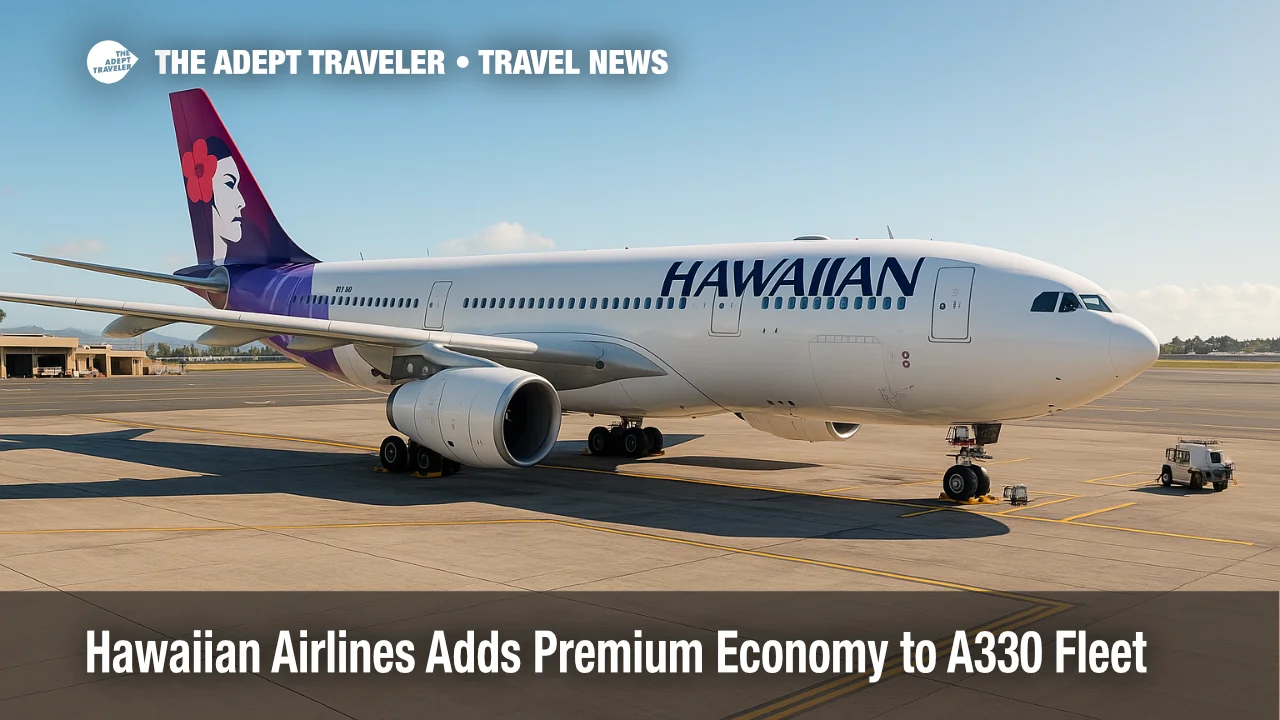Hawaiian Airlines Adds Premium Economy to A330 Fleet

Hawaiian Airlines will introduce its first premium economy cabin as part of a nose-to-tail refresh of its 24-strong Airbus A330 fleet. Parent company Alaska Air Group confirmed the upgrade will unfold over the next few years, adding wider recliners between business and main cabin while also revamping lie-flat seats up front and refreshing coach. The A330s will remain dedicated to Hawaii-centric routes, ensuring consistent wide-body service between the islands, the U.S. mainland, and key destinations in Asia and Oceania.
Key Points
- Why it matters: Hawaiian's A330 overhaul introduces the carrier's first true premium economy cabin.
- Travel impact: Wider mid-tier seats, refreshed lie-flats, and upgraded coach will roll out over several years.
- What's next: First retrofitted jet could fly by summer 2026 if maintenance slots align.
- Financial angle: Alaska Air Group aims to boost premium-seat revenue without replacing the A330 fleet.
Snapshot (114 words)
Alaska Air Group's latest fleet plan keeps Hawaiian's workhorse Airbus A330-200s front and center even as newer Boeing 787-9s migrate to Alaska-branded long-hauls from Seattle. Executives told analysts the carrier will spend "hundreds of millions" refreshing the twin-aisle jets, which average twelve years of service. The makeover adds a true international-grade premium economy cabin, remodels the 2-3-2 lie-flat business seats, upgrades main-cabin cushions, and installs new inflight entertainment and mood lighting. All twenty-four aircraft will continue to fly routes such as Honolulu-Los Angeles, Kahului-Seattle, and Honolulu-Tokyo, offering travelers more choice without sacrificing the airline's famed onboard Hawaiian hospitality.
Background (121 words)
Hawaiian Airlines received its first Airbus A330 in 2010, using the wide-body to replace aging Boeing 767s and expand nonstop service beyond the West Coast. Unlike many global competitors, the airline skipped a dedicated premium economy product, opting instead for extra-legroom "Extra Comfort" seats that retained standard coach service. Customer demand for a middle-tier experience has since surged, prompting major U.S. carriers-United, Delta, and American-to retrofit entire fleets. Hawaiian's merger with Alaska, finalized in September 2024, accelerated alignment with Alaska's strategy of monetizing premium seats. The A330 overhaul follows Alaska's ongoing retrofit of its 737 narrow-bodies and dovetails with plans to deploy Hawaiian's 787s on Alaska-operated transpacific routes.
Latest Developments
Retrofit aligns with Alaska's premium push
Alaska Air Group executives highlighted premium-seat profitability during their July 24 earnings call, noting that premium revenue already accounts for nearly a third of passenger income system-wide. Chief Financial Officer Shane Tackett told analysts the group will "reconfigure the A330s and increase the first-class cabin, putting international premium economy seats on those planes." Industry observers expect each jet to gain about twenty-eight premium economy recliners in a 2-3-2 layout, replacing rows of standard coach. Work will be staged during regular heavy-maintenance visits, minimizing downtime; the first aircraft could re-enter service as early as the 2026 summer peak, though Alaska says the full program will take "a few years" to complete.
What travelers can expect on board
Premium economy passengers will enjoy wider nineteen-inch seats with foot-rests, six-way head-rests, and thirty-eight-inch pitch. Service upgrades include plated meals inspired by Hawaiian regional cuisine, complimentary cocktails, and amenity kits featuring reef-safe sunscreen. The lie-flat business cabin keeps its 2-3-2 footprint but gains updated cushioning, wireless-charging pads, and eighteen-inch 4K monitors. Main-cabin flyers benefit from slimmer, ergonomically curved seats with personal power at every seat and Bluetooth audio pairing. The jets will retain Starlink Wi-Fi and add USB-C ports throughout. With the retrofit, Hawaiian joins leisure-focused carriers such as Virgin Atlantic and Air Tahiti Nui in banking on premium economy to satisfy travelers willing to pay extra for comfort on five- to ten-hour flights.
Analysis (233 words)
Hawaiian's decision to leap from extra-legroom coach to true premium economy underscores how quickly traveler expectations have shifted. During the 2010s the carrier's A330 rollout targeted price-sensitive leisure demand to Hawaii, where families often prized free checked bags over cabin frills. Post-pandemic booking data tell a different story: higher-income vacationers are willing to spend forty-plus percent more for added space, especially on daytime westbound legs when sleep is less critical. Alaska, meanwhile, is betting that a richer cabin mix can offset the fuel-burn disadvantage of older A330-200s versus 787s. By standardizing premium economy across both Alaska- and Hawaiian-operated fleets, the group gains pricing coherence, simplifies frequent-flyer benefits, and strengthens its West Coast hub fortress against United and Delta. The move could also mollify regulators still reviewing the merger by showing a commitment to keep wide-body capacity in the Hawaii market rather than shifting aircraft to continental routes. Execution risks remain: demand could soften if macroeconomic headwinds return, and the 2-3-2 business layout will lag rivals offering all-aisle access. Hawaiian must also balance upgrade timelines with peak-season capacity to avoid ceding share to Southwest's expanding inter-island network. Still, if Alaska manages costs, the retrofit may prove cheaper than accelerating A330 retirement while unlocking lucrative upsell revenue for years to come.
Final Thoughts (115 words)
Premium economy has become a must-have on long-haul fleets, and Hawaiian's long-awaited embrace shows that even leisure-centric airlines can no longer ignore the middle market. The A330 refresh will let the carrier match global peers on comfort, monetize rising willingness to pay, and preserve its island-themed brand identity. If timelines hold, travelers could be reclining in new seats before the decade's end, enjoying a broader range of price points on flights linking the mainland and Pacific. For Alaska Air Group and its newest subsidiary, the gamble looks well timed-and for passengers, overdue access to a better journey on Hawaiian Airlines premium economy.
